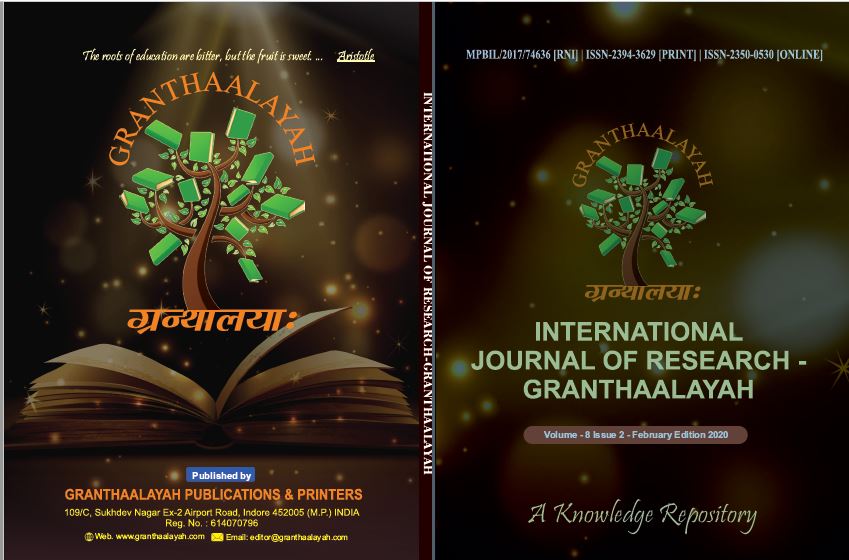ADVERSE EFFECTS OF SUBDERMAL CONTRACEPTIVE IMPLANTS IN USERS OF THE HOSPITAL: DRA. MATILDE HIDALGO DE PRÓCEL
DOI:
https://doi.org/10.29121/granthaalayah.v8.i2.2020.187Keywords:
Adverse, Contraceptive, HospitalAbstract [English]
The present study has as a priority to determine the adverse effects of subdermal contraceptive implants in the users of the Maternal and Child Hospital “Dra. Matilde Hidalgo de Prócel” from May to October 2017, a study was carried out using quantitative methodology, applying an analytical and synthetic method, through surveys applied to 98 users attended at the Matilde Hidalgo de Prócel Hospital. We found that the age group with the greatest use of implants is between 20 and 35 years old, representing 83% of the population. We determined that in the users who use the subdermal implant as a contraceptive method they have an adverse effect related to the emotional lability represented in 51%, referring to the alterations of the menstrual flow, we registered that 46% of the users who used the implant, presented an alteration of your menstrual cycle characterized by a lack of menstruation for more than 3 months. Headache was presented as the main biological effect with 31%, followed by 29% with weight gain, in terms of implant effectiveness, 43% of the users surveyed said they accessed it for its effectiveness. We found that Implanon (3 years) is the type of implant most used by the users represented by 70% of the sample.
Downloads
References
Náples Mendez D, Pilot Padrón M. Physiological foundations on suffocation in peripartum. MEDISAN [Internet]. 2014 Mar [cited 2017 Jun 11]; 18 (3): 393-407. Available in:
http://scielo.sld.cu/scielo.php?script=sci_arttext&pid=S1029-30192014000300014&lng=en.
Espinoza R J. Fetal suffering. Rev. Chil. pediatrics [Internet]. 1973 Dec [cited 2017 Jun 11]; 44 (6): 523-529. Available in: http://www.scielo.cl/scielo.php?script=sci_arttext&pid=S0370-41061973000600002 & lng = en. http://dx.doi.org/10.4067/S0370-41061973000600002 DOI: https://doi.org/10.4067/S0370-41061973000600002
Naples Méndez D. Current controversies to define alterations of fetal well-being. MEDISAN [Internet]. 2013 Mar [cited 2017 Jun 11]; 17 (3): 521-534. Available in:
http://scielo.sld.cu/scielo.php?script=sci_arttext&pid=S1029-30192013000300014&lng=en.
Ventura Laverian Wa, Mazarlo Redondo C. Sclinical ignified pathological doppler in the median cerebral artery in third trimester fetuses. Rev. Chil. obstet gynaecologist [Internet]. 2010 [cited 2017 Jun 10]; 75 (6): 405-410. Available in:
http://www.scielo.cl/scielo.php?script=sci_arttext&pid=S071775262010000600010&lng=en. http://dx.doi.org/10.4067/S0717-75262010000600010 DOI: https://doi.org/10.4067/S0717-75262010000600010
Except FB, Flowers A J, Alarcón R J, N acharH R, Walls V. Low apgar test risk factors in newborns. Rev. Chil. pediatrics [Internet]. 2007 Jun [cited 2017 Jun 10]; 78 (3): 253-260. Available in: http://www.scielo.cl/scielo.php?script=sci_arttext&pid=S037041062007000300003&lng=en. http://dx.doi.org/10.4067/S0370-41062007000300003 DOI: https://doi.org/10.4067/S0370-41062007000300003
Amador de Varona Ca I, Rodríguez Fernández J M, Mari Pichardo A, Valdés Dacal Sigfrido. Oligohydramnios: fetal health meter. AMC [Internet]. 2013 Dec [cited 2017 Jun 11]; 17 (6): 121128Availablein: http: //scielo.sld.cu/scielo.php? Script = sci_arttext & pid = S10250255201300060000 7 & lng = en
Martinovic Titiro C, Carvajal C J A. Placental brain index in adverse perinatal result prediction and fetal heart rate alterations in uncomplicated pregnancies of 40 weeks and more. Rev. Chil. obstet gynaecologist [Internet]. 2015 Dec [cited 2017 Jun 11]; 80 (6): 520-522. DOI: https://doi.org/10.4067/S0717-75262015000600014
Parra C Mauro, San Martín O A, Valdés R E, Hasbún H Jorge, Quiroz V L, Schepeler S M et al. Clinicalespectro of preeclampsia: comparative study of its varying degrees of severity. Rev. Chil. obstet gynaecologist [Internet]. 2007 [cited 2017 Jan 20]; 72 (3): 169-175. Available in: http://www.scielo.cl/scielo.php?script=sci_arttext&pid=S0717-75262007000300007&lng=en. http://dx.doi.org/10.4067/S0717-75262007000300007.
Clapés Hernández S. Diabetes mellitus, oxidative stress and pregnancy. Cuban Rev Invest Bioméd [Internet]. 2000 Dec [cited 2017 Jan 20]; 19 (3): 191-195. Available in:
http://scielo.sld.cu/scielo.php?script=sci_arttext&pid=S0864-03002000000300008&lng=en.
Peace R. From, Hernandez-Navarro F .. Management, prevention and control of pernicious anemia. Mr. Nutr. Hosp. [Internet]. 2005 Dec [cited 2017 Jun 12]; 20 (6): 433-435. Available in: http://scielo.isciii.es/scielo.php?script=sci_arttext&pid=S0212-16112005000800011&lng=en.
Martínez González L R, Torres García W, Pérez Martínez C. Experience with the fetal biophysical profile in our environment. Rev Cuban Obstet Ginecol [Internet]. 1997 Jun [cited 2017 Jan 20]; 23 (1): 31-36. Available in:
http://scielo.sld.cu/scielo.php?script=sci_arttext&pid=S0138600X1997000100006&lng=en.
Becerra César, Gonzales G F., Villena Ar, de la Cruz D, F A. Prevalence of anemia in pregnant women, Pucallpa Regional Hospital, Peru. Rev Panam Public Health [Internet]. 1998 May [cited 2017 Jan 20]; 3 (5): 285-292. Available from:
http://www.scielosp.org/scielo.php?script=sci_arttext&pid=S1020-49891998000500001&lng=en. http://dx.doi.org/10.1590/S1020-49891998000500001. DOI: https://doi.org/10.1590/S1020-49891998000500001
Tejerina Morató H. Neonatal asphyxiation. Rev. Bowl. Ped. [Internet]. 2007 Jun [cited 2017 Jun 11]; 46 (2): 145-150. Available in:
http://www.scielo.org.bo/scielo.php?script=sci_arttext&pid=S102406752007000200012&lng=en.
Downloads
Published
How to Cite
Issue
Section
License
With the licence CC-BY, authors retain the copyright, allowing anyone to download, reuse, re-print, modify, distribute, and/or copy their contribution. The work must be properly attributed to its author.
It is not necessary to ask for further permission from the author or journal board.
This journal provides immediate open access to its content on the principle that making research freely available to the public supports a greater global exchange of knowledge.






























